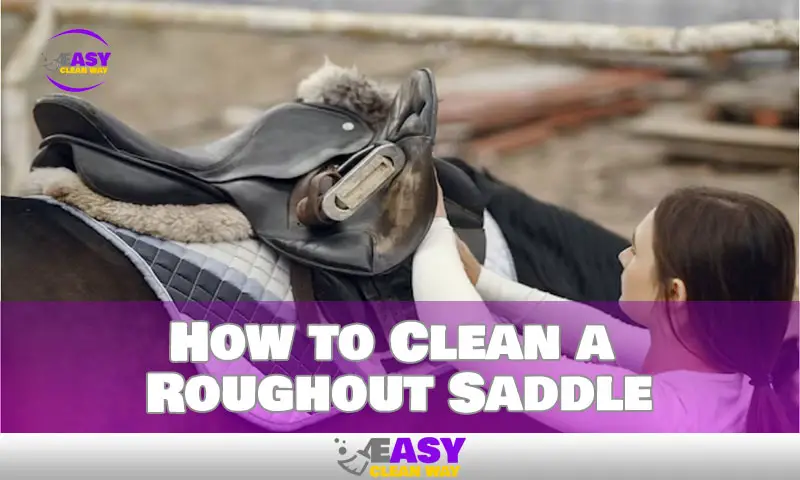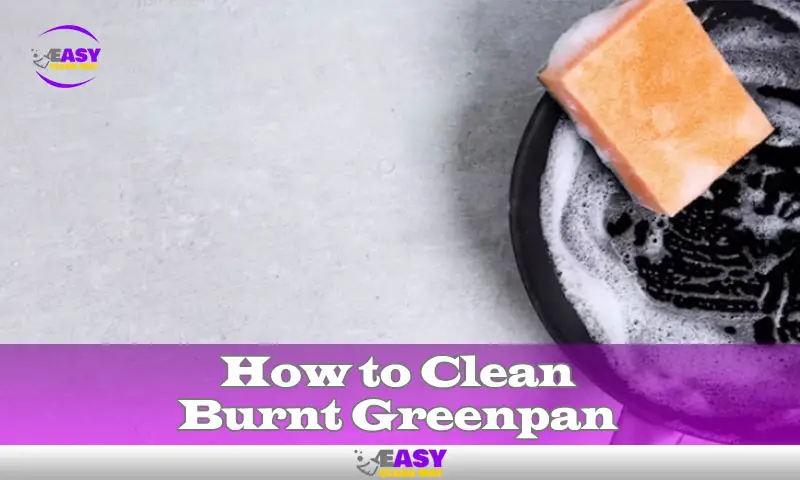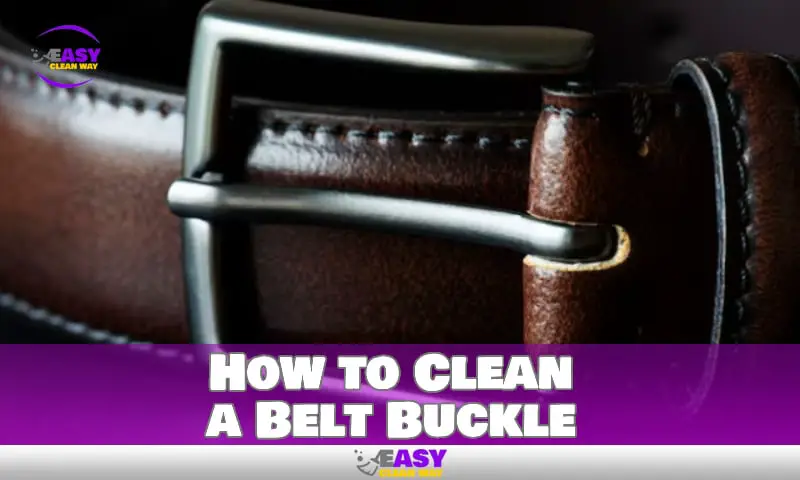To clean a roughout saddle, use a stiff brush to remove dirt and debris, then apply saddle soap and water with a soft scrub brush using circular motions. Cleaning a roughout saddle is an essential task to keep it looking good and increase its lifespan.
A roughout saddle is made of leather, specially crafted for a better grip with a rough texture. Unlike smooth leather, a roughout saddle can be tough to clean. This type of saddle is mainly used for western-style riding, where cowboys are expected to clean it after a long, hard day on the trail.
The primary reason to clean a roughout saddle is to remove the sweat, grime, and dirt that accumulate after use. In this article, we will discuss how to clean a roughout saddle, and the necessary steps to follow to restore its look.
What Is Roughout Leather And How Is It Different From Smooth Leather?
Roughout leather is a type of leather with the rougher side of the hide facing outward. This creates a more textured surface, which provides a better grip for riders. In contrast, smooth leather has been buffed or sanded so that its surface is smooth and sleek.
It is important to know the difference between the two in order to properly take care of your roughout saddle.
Here are some other key points to keep in mind when comparing the two:
- Roughout leather tends to be more durable and hard-wearing than smooth leather.
- Roughout leather can be harder to clean than smooth leather, as dirt and grime can get trapped in the nap of the leather.
- Smooth leather is generally considered easier to maintain, as it can be wiped down with a damp cloth and saddle soap.
The Importance Of Cleaning Your Roughout Saddle
Cleaning your roughout saddle is essential to maintaining its appearance and function. A dirty saddle can lead to a buildup of dirt and sweat, which can cause the leather to harden and crack over time and even cause your horse irritation or infection.
Here are some additional reasons to clean your roughout saddle regularly:
- Regular cleaning can maintain the integrity of your saddle, ensuring that it lasts for years to come.
- Cleaning can help prevent the buildup of bacteria and fungus that can lead to skin irritations or infections in your horse.
- A clean saddle is a more comfortable saddle – for both the rider and the horse.
- Regular cleaning allows you to inspect your saddle for wear and tear or damage, which can help you identify issues before they become more serious.
Now that we’ve covered why it’s important to clean your roughout saddle, let’s move on to the practical steps you can take to ensure that your saddle is always in top condition.
Tools You’ll Need For Cleaning A Roughout Saddle
Cleaning a roughout saddle can seem like a daunting task when you are uncertain about what tools and products to use. But, with the right tools, your saddle’s leather will appear and feel as good as new. Here’s what you will require to get started:
List The Necessary Tools For Cleaning A Roughout Saddle:
- Soft-bristled brush
- Saddle soap
- Leather conditioner
- A small bucket
- Clean rags
Now, let’s take a closer look at each of these tools and why they are important to clean your roughout saddle:
- Soft-bristled brush: Use a soft-bristled brush to remove any visible dirt or dust on the saddle’s surface without causing any damage. Gently brush the leather in circular motions, ensuring that no spot is left uncleaned.
- Saddle soap: Saddle soap is specially formulated for leather goods, including saddles. It will remove grime, sweat, and salt stains without harming the leather’s finish. Wet your brush, apply a small amount of saddle soap, and gently scrub your saddle’s surface. You can also use a damp cloth with a little saddle soap on it for deep cleaning.
- Leather conditioner: Leather conditioner is essential for keeping the saddle supple and healthy. The leather can dry out, crack, and become stiff without conditioning. Apply leather conditioner generously to the entire saddle, ensuring that all parts receive proper attention. Let it soak in for 5-10 minutes before wiping off the excess.
- A small bucket: You’ll need a small bucket to hold the water when cleaning the saddle. Keep the water warm, but not boiling, as boiling water can harm the leather. You can also add a small amount of saddle soap to the water for extra cleaning power.
- Clean rags: You’ll need clean rags to dry the saddle after cleaning and conditioning. Use a soft, clean rag to gently wipe any excess conditioner from the saddle. Ensure that you cover every part of the saddle.
Product Recommendations For Cleaning Solutions, Brushes, And Other Tools:
- Soft-bristled brush: A horsehair brush is gentle and durable, and it is the best choice for cleaning saddles. You can get it from any tack shop or online.
- Saddle soap: Fiebing’s saddle soap is the go-to choice of saddle soap for many horse owners and riders.
- Leather conditioner: Bickmore’s Back 4 leather conditioner is highly recommended and widely used in the equestrian community.
- Clean rags: You can use old t-shirts, towels, or cleaning cloths as rags. Just make sure they are clean and soft to prevent any scratches on the leather surface.
With these essential tools and products, you can keep your roughout saddle in pristine condition for years to come. Proper care and maintenance of your saddle will give you a better riding experience and increase your saddle’s lifespan. Remember to clean your saddle regularly, especially after a long ride or everyday use.
Step-By-Step Guide To Cleaning Your Roughout Saddle
Roughout saddles are popular among riders for their great grip and unique texture. However, they require special care and attention to keep them looking their best. In this post, we will provide you with a step-by-step guide for cleaning your roughout saddle.
Provide A Step-By-Step Guide For Cleaning A Roughout Saddle.
Cleaning your roughout saddle doesn’t have to be a daunting task. Follow these simple steps to ensure your saddle stays in top condition:
- Start by brushing off any dirt, hair, or debris with a stiff-bristled brush. This will help to loosen any dirt that may be stuck to the saddle.
- Next, mix a tablespoon of mild soap with a quart of water. Avoid using harsh chemicals, as this can damage the saddle’s leather and texture.
- Dip a soft-bristled brush or sponge into the mixture and gently rub the saddle in circular motions. Be sure to cover every inch of the saddle, including the underside.
- Avoid getting the saddle too wet, as this can damage the leather. Use a damp cloth to wipe off any soap residue.
- Rinse the sponge or brush and wipe down the saddle with clean water.
- Use a clean towel to pat the saddle dry, removing any excess water.
- Allow the saddle to air dry completely before conditioning.
Include Tips For Dealing With Particularly Dirty Spots Or Stubborn Stains.
Sometimes, roughout saddles can develop dirty spots or stubborn stains that can be difficult to remove. Here are some tips to help you deal with them:
- For stubborn stains, mix a small amount of vinegar with water and apply it to the affected area. Allow it to sit for a few minutes before wiping it off with a clean cloth.
- For particularly dirty spots, try using a suede eraser or a suede brush. Rub the spot gently in a circular motion until the dirt is removed.
- Avoid using too much water on dirty spots, as this can cause the leather to become distorted.
Mention How To Properly Dry And Condition The Saddle Leather Afterward
Drying and conditioning your saddle is an essential part of the cleaning process. Here are some steps to follow:
- After cleaning, leave your saddle to air dry completely. Avoid using any artificial heat source to dry it, as this can cause the leather to warp and crack.
- Once dry, apply a leather conditioner to the saddle. Use a cloth to evenly distribute the conditioner and ensure all areas are covered.
- Allow the conditioner to soak in for a few minutes before wiping off any excess with a clean cloth.
- Store your saddle in a cool, dry place to prevent mildew and moisture buildup.
By following these simple steps, you can keep your roughout saddle looking and feeling great, ensuring it lasts for many rides to come!
Common Mistakes To Avoid When Cleaning A Roughout Saddle
Roughout saddles provide a unique and durable finish that can withstand tough riding conditions, which makes them a popular choice among horse riders. However, to ensure that your saddle lasts longer, you must clean it regularly. Cleaning a roughout saddle is not as easy as it seems, and making mistakes during the process can damage the material.
In this section, we’ll explore the common mistakes to avoid when cleaning a roughout saddle and provide tips to help you maintain your saddle’s longevity.
List Common Mistakes People Make When Cleaning Roughout Saddles And Why They Should Be Avoided:
- Using harsh cleaning agents – roughout saddles are made of suede leather and using harsh cleaning agents can damage the material. These cleaning materials can strip the leather of essential oils and cause it to crack, which weakens the saddle and shortens its lifespan.
- Over-saturating the saddle – roughout saddles are prone to water damage, and if you over-saturate the saddle while cleaning it, you risk damaging the material. Over-saturation can cause the saddle to become stiff and brittle, resulting in cracks and a shortened lifespan.
- Scrubbing too hard – scrubbing the saddle too hard can damage the material and cause it to lose its texture. The roughout material is delicate, and excessive scrubbing can cause the suede to fray, resulting in an uneven and rough appearance.
Tips For Avoiding These Mistakes And Maintaining The Longevity Of Your Saddle:
- Use a non-abrasive, suede-safe cleaner – when cleaning a roughout saddle, it’s important to use a gentle cleaning agent that won’t damage the material. The cleaner should be specially formulated for suede leather to ensure optimal cleaning results without harming the rough-out finish.
- Use a damp sponge or cloth – to avoid over-saturation, use a damp sponge or cloth instead of a hose while cleaning your roughout saddle. This will help remove any dirt or debris while minimizing the risk of water damage.
- Gently clean with light pressure – when cleaning a roughout saddle, use a gentle circular motion with light pressure. Avoid heavy scrubbing to prevent damage to the suede surface.
By avoiding these common mistakes and following the tips outlined above, you can maintain the longevity of your roughout saddle. Regular cleaning and maintenance will help keep your saddle looking great and performing well for years to come.
Alternative Methods For Cleaning A Roughout Saddle
When it comes to maintaining a roughout saddle, the cleaning process can be a bit challenging. Traditional soap and water may not be enough to get rid of stains, dirt, and grime that are stuck deep within the rough texture of the saddle.
Thankfully, there are alternative methods for cleaning a roughout saddle that you can try. Here are some of them:
Using A Steam Cleaner
One way to clean a roughout saddle is by using a steam cleaner. A steam cleaner works by using hot steam to loosen and remove dirt and stains. Here are the pros and cons of using a steam cleaner:
Pros:
- Effective at cleaning deep stains and dirt
- A chemical-free cleaning method
- Sanitizes the saddle by killing bacteria and germs
cons:
- The cost of buying a steam cleaner can be high
- The cleaning process can be time-consuming
- Sensitive individuals may have allergic reactions to steam or the cleaning solutions used
Using A Vinegar Solution
Another alternative method for cleaning a roughout saddle is to use vinegar. The acidity of vinegar makes it an effective cleaning agent for tough stains and grime. Here are the pros and cons of using a vinegar solution:
Pros:
- A cheap and natural cleaning solution
- Effective at removing tough stains and dirt
- Safe for both the saddle’s leather and roughout surface
cons:
- The strong smell of vinegar may be unpleasant
- The cleaning process may take a longer time for tougher stains
- May not be as effective against stubborn grease stains
When it comes to cleaning a roughout saddle, it’s essential to use the right cleaning method to ensure that the saddle stays in good condition. While both steam cleaners and vinegar solutions are effective, they have their pros and cons.
If you’re looking for a chemical-free and safe cleaning method, then a vinegar solution may work for you. However, if you have lots of deep stains or grime to remove, a steam cleaner may be a better choice.
People Also Like: How to Clean a Matte Black Wrapped Car with Proven Tricks
FAQs
How Do You Clean A Roughout Saddle?
Gently use a soft brush to remove dirt and dust. Apply saddle soap and blot any excess with a damp cloth. Let it dry, and brush it again.
What Is A Roughout Saddle?
Roughout saddles are those whose seats and panels are covered with rough leather instead of smooth leather. They offer more grip.
Can I Use Regular Soap On A Roughout Saddle?
No, regular soap can damage the rough leather and leave a residue. Only use saddle soap specifically designed for cleaning leather saddles.
How Often Should I Clean My Roughout Saddle?
Clean your roughout saddle after every use to remove sweat and dirt. It will keep the saddle looking good and increase its lifespan.
Conclusion
Overall, cleaning a roughout saddle can seem like a daunting task, but with the right tools and techniques, it can be done easily and effectively. Remember to start by gently brushing off any loose dirt or debris before applying a cleaning solution.
Then, focus on small sections at a time, using a soft brush or cloth to work the solution into the roughout. Allow the saddle to dry completely before applying any conditioning products, which will help to maintain the suede-like texture.
Lastly, storing your saddle in a cool, dry place will help to prolong its life and ensure it stays looking and performing at its best. By following these steps, you can keep your roughout saddle in top condition for years to come.
Hey there! I’m Alton Smith, your Clean Expert blogger. I’m on a quest to help you conquer chaos and embrace the joys of a tidy life.





